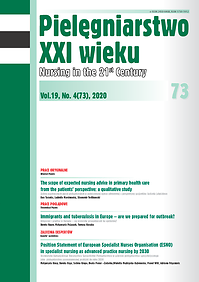Suicide attempts at the age of 10-18 in Lublin
DOI:
https://doi.org/10.2478/pielxxiw-2020-0023Keywords:
suicide attempt, juvenile, LublinAbstract
SUICIDE ATTEMPTS AT THE AGE OF 10-18 IN LUBLIN
Introduction. The number of children and adolescents hospitalized due to suicide attempts caused by stress, low self-esteem, lack of acceptance and peer violence, as well as family problems, increases every year. In addition, there may occur disturbed self-perception or depression. This is a very complex phenomenon, the scale of which should induce immediate multidimensional activities.
Aim. Analysis of the occurrence of suicide attempts among minors on the example of the city of Lublin.
Material and methods. The statistical data obtained from the Polish Police Headquarter and from the report of the Foundation We Give Children Strength – “Children count 2017” was analyzed and a review of the literature on the subject for the years 2014-2018 developed using the descriptive method was made.
Results. The report of the Foundation We Give Children Strength shows a huge scale of the phenomenon. According to its data, as many as 72% of children aged 11-17 have experienced at least one form of abuse in their lives, 7% of respondents have attempted suicide, and 16% of teenagers have mutilated themselves. The statistics conducted in Poland in 2017-2018 recorded: in 2017 the number of 116, and in 2018 – 97 suicide attempts ended in death. There were 5 deaths in 2017 and 9 in 2018 in Lubelskie Voivodeship, what shows an increase by 80% in 12 months. In the 7-12 age group in 2017, only one suicide attempt ended up in death was reported, in 2018 the number increased to 5 – none of them concerned the Lublin Province.
Conclusions. Suicide attempts ending up in death in 2018 accounted for 2.30% of suicide attempts undertaken in Lublin, while in Poland they constituted 1.87%. The main reasons for suicide attempts among minors are: the lack of acceptance, low self-esteem and peer violence, both physical and mental. Mass media have an infl uence on juvenile suicides. Belief in “multiple lives” perpetuated by computer games and films can have an impact on suicide attempts.
References
1. Sajkowska M. (red. naczelna): Dzieci się liczą 2017. Raport o zagrożeniach bezpieczeństwa i rozwoju dzieci w Polsce. Fundacja Dajemy Dzieciom Siłę. Dziecko krzywdzone. Teoria, badania, praktyka. 2017; 16(1).
2. Szmajda R, Gmitrowicz A. Selected mental health problems in institutionally reared children (Wybrane problemy z zakresu zdrowia psychicznego wśród nastolatków w wychowaniu instytucjonalnym). Psychiatria i Psychologia Kliniczna. 2018; 4(18), 354-363.
3. Włodarczyk J. Śmierć dzieci jako konsekwencja krzywdzenia i/lub zaniedbania. Dziecko krzywdzone. 2012; 2(39), 104-115.
4. Mrozek A. Dziecko maltretowane inaczej. Psychiatria i Psychologia Kliniczna. 2005; 5(2), 79-86.
5. Rutkowska A, Łopuszańska U, Świder K, et al. The analysis of family risk factors associated with the occurrence of suicidal attempts among girls aged 12-16 years old. A pilot study (Analiza rodzinnych czynników ryzyka występowania prób samobójczych w grupie dziewcząt w wieku 12-16 lat. Badania pilotażowe). Psychiatria i Psychologia Kliniczna. 2015, 15(3), 126-130.
6. Statystyki Komendy Głównej Policji: http://statystyka.policja.pl/st/wybrane-statystyki/zamachy-samobojcze [dostęp 05.07.2019].
7. Makara-Studzińska M. Przyczyny prób samobójczych u młodzieży w wieku 14-18 lat. Psychiatria. 2013; 10(2), 76–83.
8. Putowski M, Piróg M, Podgórniak M, i wsp. Analiza epidemiologiczna występowania samobójstw w Polsce w latach 2000-2013. Problemy Higieny i Epidemiologii. 2015, 96(1), 264-268.
9. Stradomska M, Wolińska J, Marczak M. Circumstances and underlying causes of suicidal attempts in teen patients of mental health facilities – a psychological perspective (Uwarunkowania prób samobójczych u nastoletnich pacjentów szpitali i klinik psychiatrycznych w perspektywie psychologicznej). Psychiatria i Psychologia Kliniczna. 2016; 16(3), 136-149.
10. Krajewska K, Florkowski A, Gmitrowicz A. Związek zespołu zależności alkoholowej rodziców z występowaniem prób samobójczych wśród nastoletnich pacjentów hospitalizowanych psychiatrycznie. Psychiatria i Psychologia Kliniczna. 2014; 14(3), 196-201.
11. Makara-Studzińska M, Łopuszańska U, Sidor K, i wsp. Violence, suicidal attempts and relationships with parents in a group of adolescent girls. Pilot studies (Doświadczanie przemocy ze strony rówieśników, próby samobójcze i relacje z rodzicami w grupie nastoletnich dziewcząt. Badania pilotażowe). Psychiatria i Psychologia Kliniczna. 2017, 17(3), 172-178.
12. Chwin S. Samobójstwo jako doświadczenie wyobraźni. Gdańsk 2010.
13. Pietkiewicz B. Samobójstwo zaraźliwe jak choroba. W: https://www.polityka.pl/ tygodnikpolityka/spoleczenstwo/1521747,1,samobojstwo-zarazliwe-jak-choroba [dostęp: 09.07.2019].
14. Kropidłowski M. Religie wobec samobójstwa. W: http://www.racjonalista.pl/ kk.php/s,3948 [dostęp: 11.07.2019].
15. Galińska I. Życiowy tunel. https://opoka.org.pl/biblioteka/I/IP/niedziela201505- samobojstwo.html [dostęp: 09.07.2019].
Downloads
Published
Issue
Section
License
Copyright (c) 2020 Authors

This work is licensed under a Creative Commons Attribution-NonCommercial-NoDerivatives 3.0 Unported License.




